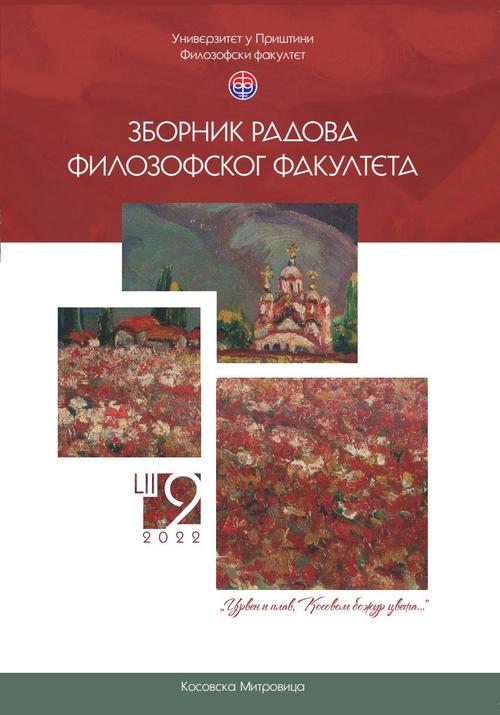Yugoslav–Romanian Alliance Between the Two World Wars (Little Entente and Balkan Pact)
Abstract
With the creation of the Kingdom of Serbs, Croats, and Slovenes after the First World War, the new state got the Kingdom of Romania as a neighbour. Disagreements that existed between the two countries regarding the demarcation in Banat were resolved by the marriage of the King Alexander I Karađorđević and the Romanian Princess Maria Hohenzollern. The royal marriage was the basis for further development of allied relations between the states in the period between the two world wars. The partnership was strengthened by military-political pacts within the framework of the Little Entente and the Balkan Pact. The peace treaties concluded during the Versailles Conference did not guarantee the security of minor European countries such as the Kingdom of SHS and Romania. The revisionist aspirations of the joint neighbours of Hungary and Bulgaria developed friendly relations that Belgrade and Bucharest needed to deter the enemy from taking any action. The Yugoslav public viewed Romania as a friendly country, so diplomatic activities within the two alliances were closely monitored by the press. In addition, many public workers were concerned with analysing perspectives that could benefit the two countries in the future. The fact that Romania was a significant ally was evidenced by the fact that in December 1938 the mission was promoted to the rank of embassy, which was the first embassy in the diplomatic history of the Kingdom of Yugoslavia. In this paper, we intend to present the development of allied relations between the two countries, based on the historical reach of the historiography, as well as the analysis of the writing of the Yugoslav press. Particular attention will be paid to the challenges that the alliances faced during the Third Reich’s penetration into southeast Europe. Although the allies of the Kingdom of Yugoslavia and Romania would find themselves on opposite sides in World War II, there was no mutual war between the two countries, which was a consequence of the built relations in the interwar period.
References
Аврамовски, Ж. (1979). Југословенско-румунски односи за време Рајнске кризе 1936. године. Историјски гласник, 1–2, 135–140.
Бодрожић, М. (2001). Спољна политика Краљевине Југославије у време владавине Југословенске националне странке 1932–1934. године. Зборник Матице српске за историју, 63–64, 277–290.
Ванку, М. (1969). Мала Антанта 1920–1938. Титово Ужице: Издавачко предузеће „Димитрије Туцовић“.
Гулић, М. (2014). Краљевина Југославија и Дунав: дунавска политика југословенске краљевине 1918–1944. Београд: Институт за савремену историју.
Крофта, К. (1937). Мала Антанта, њен развој и њена важност. Летопис Матице српске, CXI, 348 (3), 225–230.
Маринковић, А. (2004). Женидба краља Александра Карађорђевића. Београд: Вајат.
Милановић, Ј. (2017). Краљица Марија Карађорђевић и Женско друштво 1922–1941. У: К. Николић (ур.), Карађорђе и његово наслеђе у српској историји (227–242). Велика Плана – Старо Село – Београд: Центар за културу Масука – Дом културе Влада Марјановић – Институт за савремену историју.
Милошевић, З. (2018). Узроци и околности који су утицали на предају источног Баната Румунији од стране Краљевине Срба, Хрвата и Словенаца (Југославије) после Првог светског рата. Национални интерес, XIV, 33 (3), 127–141.
Милошевић, М. и Јончић, Д. (2012). Јован Дучић у дипломатији. Београд: Архив Југославије.
Попи, Г. (1972). Из политичке активности Румуна у Банату после Првог светског рата. Зборник за историју, 6, 173–176.
Радовановић, М. (1937). Мала Антанта и средњоевропско питање. Летопис Матице српске, CXI, 348 (2), 190–201.
Сладек, З. (2019). Мала Антанта 1919–1938. Београд: Службени гласник.
Сретеновић, С. (2008). Француска и Краљевина Срба, Хрвата и Словенаца 1918– 1929. Београд: Институт за савремену историју.
Ћирковић, С. (1935а). Политичка и привредна Мала Антанта. Летопис Матице српске, CIX, 343 (4), 261–294.
Ћирковић, С. (1935б). Смисао и значај Пакта Балканског споразума. Осврти, 3, 19–23.
Церовић, Љ. (2000). Срби у Румунији. Темишвар: Савез Срба у Румунији.
Janjetović, Z. (2005). Deca careva, pastorčad kraljeva: nacionalne manjine u Jugoslaviji: 1918–1941. Beograd: Institut za noviju istoriju Srbije.
Krizman, B. (1975). Vanjska politika Jugoslavenske države 1918–1941. Zagreb: Školska knjiga.
Lukač, D. (1982). Т. 1: Treći rajh i zemlje jugoistočne Evrope 1933–1936. Beograd: Vojnoizdavački zavod; Balkanološki institut SANU; Prosveta; Rad.
Maran, M. (2004). Kulturni razvoj Rumuna u Banatu 1918–1941. Pančevo: Istorijski arhiv.
Petranović, B. (1988). Т. 1: Istorija Jugoslavije: 1918–1988. Beograd: Nolit.
Popi, G. (1974). Formiranje, razvoj i delovanje Rumunske stranke (1923–1929). Istraživanja, 3, 309–365.
Popi, G. (1984). Jugoslovensko-rumunski odnosi: 1918–1941. Novi Sad: Filozofski fakultet, Institut za istoriju.
Vanku, M. (2005). Srpsko-jugoslovensko-rumunski odnosi kroz vekove. Beograd: Stručna knjiga.
Vinaver, V. (1971). Jugoslavija i Mađarska: 1918–1933. Beograd: Institut za savremenu istoriju.
The details about the publication policy, including copyright and licensing, are available at:

